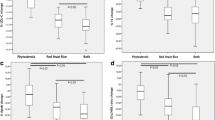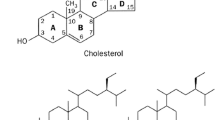Abstract
Purpose
Red yeast rice (RYR), sugar cane-derived policosanols (SCdP) and artichoke leaf extracts (ALEs) are currently incorporated alone or in combination into dietary supplements for their potential low-density-lipoprotein cholesterol (LDL-cholesterol)-lowering effects. Yet, there is no information supporting the efficacy of this association on the reduction in LDL-cholesterol. The main objective of this study was to investigate the effects of a new dietary supplement (DS) with RYR, SCdP and ALEs on LDL-cholesterol.
Methods
In a double-blind, randomized, parallel controlled study, 39 subjects from 21 to 55 years with moderate hypercholesterolemia without drug treatment were assigned to 2 groups and then consumed either a DS containing RYR, SCdP and ALEs or a placebo over a 16-week period. Plasma concentrations of lipids [LDL-cholesterol, total cholesterol (TC), high-density-lipoprotein cholesterol (HDL-cholesterol), triacylglycerols (TG)] and plasma levels of vitamins C and E, total polyphenols and malondialdehyde were determined at baseline and after 4, 8, 12 and 16 weeks.
Results
LDL-cholesterol and TC were reduced by, respectively, 21.4 % (95 % CI, −13.3 to −24.9 %, p < 0.001) and 14.1 % (95 % CI, −10.1 to −18.0 %, p < 0.001) at week 16 in the DS group compared with baseline. Similar results were obtained at weeks 4, 8 and 12. TG decreased by 12.2 % after 16 weeks in the DS group (95 % CI: −24.4 to −0.1 %, p < 0.05). For the vitamin E/TC ratio, a difference was observed between groups at week 16 (p < 0.05). Other parameters were not modified.
Conclusions
Daily consumption of this new DS decreased LDL-cholesterol and TC and is therefore an interesting, convenient aid in managing mild to moderate hypercholesterolemia.

Similar content being viewed by others
References
Wilson PW, Castelli WP, Kannel WB (1987) Coronary risk prediction in adults (the Framingham Heart Study). Am J Cardiol 59:91G–94G
Robinson JG, Smith B, Maheshwari N, Schrott H (2005) Pleiotropic effects of statins: benefit beyond cholesterol reduction? A meta-regression analysis. J Am Coll Cardiol 46:1855–1862
Baigent C, Keech A, Kearney PM, Blackwell L, Buck G, Pollicino C, Kirby A, Sourjina T, Peto R, Collins R, Simes R (2005) Efficacy and safety of cholesterol-lowering treatment: prospective meta-analysis of data from 90,056 participants in 14 randomised trials of statins. Lancet 366:1267–1278
Vondrakova D, Ostadal P, Kruger A (2010) Immediate effect of intensive atorvastatin therapy on lipid parameters in patients with acute coronary syndrome. Lipids Health Dis 9:71
Kelly JP, Kaufman DW, Kelley K, Rosenberg L, Anderson TE, Mitchell AA (2005) Recent trends in use of herbal and other natural products. Arch Intern Med 165:281–286
Expert Panel on Detection, Evaluation, and Treatment of High Blood Cholesterol in Adults (2001) Executive summary of the third report of the National Cholesterol Education Program (NCEP) Expert Panel on Detection, Evaluation, and Treatment of High Blood Cholesterol in Adults (Adult Treatment Panel III). JAMA 285:2486–2497
Nijjar PS, Burke FM, Bloesch A, Rader DJ (2010) Role of dietary supplements in lowering low-density lipoprotein cholesterol: a review. J Clin Lipidol 4:248–258
Bogsrud MP, Ose L, Langslet G, Ottestad I, Strom EC, Hagve TA, Retterstol K (2010) HypoCol (red yeast rice) lowers plasma cholesterol: a randomized placebo controlled study. Scand Cardiovasc J 44:197–200
Lin CC, Li TC, Lai MM (2005) Efficacy and safety of Monascus purpureus Went rice in subjects with hyperlipidemia. Eur J Endocrinol 153:679–686
Heber D, Yip I, Ashley JM, Elashoff DA, Elashoff RM, Go VL (1999) Cholesterol-lowering effects of a proprietary Chinese red-yeast-rice dietary supplement. Am J Clin Nutr 69:231–236
Huang CF, Li TC, Lin CC, Liu CS, Shih HC, Lai MM (2007) Efficacy of Monascus purpureus Went rice on lowering lipid ratios in hypercholesterolemic patients. Eur J Cardiovasc Prev Rehabil 14:438–440
Liu J, Zhang J, Shi Y, Grimsgaard S, Alraek T, Fonnebo V (2006) Chinese red yeast rice (Monascus purpureus) for primary hyperlipidemia: a meta-analysis of randomized controlled trials. Chin Med 1:4
Heber D, Lembertas A, Lu QY, Bowerman S, Go VL (2001) An analysis of nine proprietary Chinese red yeast rice dietary supplements: implications of variability in chemical profile and contents. J Altern Complement Med 7:133–139
Chen JT, Wesley R, Shamburek RD, Pucino F, Csako G (2005) Meta-analysis of natural therapies for hyperlipidemia: plant sterols and stanols versus policosanol. Pharmacotherapy 25:171–183
Gouni-Berthold I, Berthold HK (2002) Policosanol: clinical pharmacology and therapeutic significance of a new lipid-lowering agent. Am Heart J 143:356–365
Wider B, Pittler MH, Thompson-Coon J, Ernst E (2009) Artichoke leaf extract for treating hypercholesterolaemia. Cochrane Database Syst Rev CD003335
Kaplan M, Aviram M (1999) Oxidized low density lipoprotein: atherogenic and proinflammatory characteristics during macrophage foam cell formation. An inhibitory role for nutritional antioxidants and serum paraoxonase. Clin Chem Lab Med 37:777–787
Toshima S, Hasegawa A, Kurabayashi M, Itabe H, Takano T, Sugano J, Shimamura K, Kimura J, Michishita I, Suzuki T, Nagai R (2000) Circulating oxidized low density lipoprotein levels. A biochemical risk marker for coronary heart disease. Arterioscler Thromb Vasc Biol 20:2243–2247
Bowen PE, Borthakur G (2004) Postprandial lipid oxidation and cardiovascular disease risk. Curr Atheroscler Rep 6:477–484
Romero FJ, Bosch-Morell F, Romero MJ, Jareno EJ, Romero B, Marin N, Roma J (1998) Lipid peroxidation products and antioxidants in human disease. Environ Health Perspect 106(Suppl 5):1229–1234
Losonczy KG, Harris TB, Havlik RJ (1996) Vitamin E and vitamin C supplement use and risk of all-cause and coronary heart disease mortality in older persons: the Established Populations for Epidemiologic Studies of the Elderly. Am J Clin Nutr 64:190–196
Rimm EB, Stampfer MJ, Ascherio A, Giovannucci E, Colditz GA, Willett WC (1993) Vitamin E consumption and the risk of coronary heart disease in men. N Engl J Med 328:1450–1456
Stampfer MJ, Hennekens CH, Manson JE, Colditz GA, Rosner B, Willett WC (1993) Vitamin E consumption and the risk of coronary disease in women. N Engl J Med 328:1444–1449
Friedewald WT, Levy RI, Fredrickson DS (1972) Estimation of the concentration of low-density lipoprotein cholesterol in plasma, without use of the preparative ultracentrifuge. Clin Chem 18:499–502
Hu FB, Willett WC (2002) Optimal diets for prevention of coronary heart disease. JAMA 288:2569–2578
Mente A, de Koning L, Shannon HS, Anand SS (2009) A systematic review of the evidence supporting a causal link between dietary factors and coronary heart disease. Arch Intern Med 169:659–669
Reiner Z, Catapano AL, De Backer G, Graham I, Taskinen MR, Wiklund O, Agewall S, Alegria E, Chapman MJ, Durrington P, Erdine S, Halcox J, Hobbs R, Kjekshus J, Filardi PP, Riccardi G, Storey RF, Wood D, Bax J, Vahanian A, Auricchio A, Baumgartner H, Ceconi C, Dean V, Deaton C, Fagard R, Filippatos G, Funck-Brentano C, Hasdai D, Hoes A, Kearney P, Knuuti J, Kolh P, McDonagh T, Moulin C, Poldermans D, Popescu BA, Sechtem U, Sirnes PA, Tendera M, Torbicki A, Vardas P, Widimsky P, Windecker S, Berkenboom G, De Graaf J, Descamps O, Gotcheva N, Griffith K, Guida GF, Gulec S, Henkin Y, Huber K, Kesaniemi YA, Lekakis J, Manolis AJ, Marques-Vidal P, Masana L, McMurray J, Mendes M, Pagava Z, Pedersen T, Prescott E, Rato Q, Rosano G, Sans S, Stalenhoef A, Tokgozoglu L, Viigimaa M, Wittekoek ME, Zamorano JL (2011) ESC/EAS guidelines for the management of dyslipidaemias: the Task Force for the management of dyslipidaemias of the European Society of Cardiology (ESC) and the European Atherosclerosis Society (EAS). Eur Heart J 32:1769–1818
Sirtori CR, Galli C, Anderson JW, Arnoldi A (2009) Nutritional and nutraceutical approaches to dyslipidemia and atherosclerosis prevention: focus on dietary proteins. Atherosclerosis 203:8–17
Endo A (1979) Monacolin K, a new hypocholesterolemic agent produced by a Monascus species. J Antibiot (Tokyo) 32:852–854
Becker DJ, Gordon RY, Halbert SC, French B, Morris PB, Rader DJ (2009) Red yeast rice for dyslipidemia in statin-intolerant patients: a randomized trial. Ann Intern Med 150:830–839
Journoud M, Jones PJ (2004) Red yeast rice: a new hypolipidemic drug. Life Sci 74:2675–2683
Guardamagna O, Abello F, Baracco V, Stasiowska B, Martino F (2011) The treatment of hypercholesterolemic children: efficacy and safety of a combination of red yeast rice extract and policosanols. Nutr Metab Cardiovasc Dis 21:424–429
Reiner Z, Tedeschi-Reiner E, Romic Z (2005) Effects of rice policosanol on serum lipoproteins, homocysteine, fibrinogen and C-reactive protein in hypercholesterolaemic patients. Clin Drug Investig 25:701–707
Castano G, Mas R, Fernandez L, Illnait J, Gamez R, Alvarez E (2001) Effects of policosanol 20 versus 40 mg/day in the treatment of patients with type II hypercholesterolemia: a 6-month double-blind study. Int J Clin Pharmacol Res 21:43–57
Castano G, Fernandez L, Mas R, Illnait J, Mesa M, Fernandez JC (2003) Comparison of the effects of policosanol and atorvastatin on lipid profile and platelet aggregation in patients with dyslipidaemia and type 2 diabetes mellitus. Clin Drug Investig 23:639–650
Prat H, Roman O, Pino E (1999) Comparative effects of policosanol and two HMG-CoA reductase inhibitors on type II hypercholesterolemia. Rev Med Chil 127:286–294
Singh DK, Li L, Porter TD (2006) Policosanol inhibits cholesterol synthesis in hepatoma cells by activation of AMP-kinase. J Pharmacol Exp Ther 318:1020–1026
Marazzi G, Cacciotti L, Pelliccia F, Iaia L, Volterrani M, Caminiti G, Sposato B, Massaro R, Grieco F, Rosano G (2011) Long-term effects of nutraceuticals (berberine, red yeast rice, policosanol) in elderly hypercholesterolemic patients. Adv Ther 28:1105–1113
Francini-Pesenti F, Brocadello F, Beltramolli D, Nardi M, Caregaro L (2008) Sugar cane policosanol failed to lower plasma cholesterol in primitive, diet-resistant hypercholesterolaemia: a double blind, controlled study. Complement Ther Med 16:61–65
Cubeddu LX, Cubeddu RJ, Heimowitz T, Restrepo B, Lamas GA, Weinberg GB (2006) Comparative lipid-lowering effects of policosanol and atorvastatin: a randomized, parallel, double-blind, placebo-controlled trial. Am Heart J 152(982):e981–e985
Berthold HK, Unverdorben S, Degenhardt R, Bulitta M, Gouni-Berthold I (2006) Effect of policosanol on lipid levels among patients with hypercholesterolemia or combined hyperlipidemia: a randomized controlled trial. JAMA 295:2262–2269
Gebhardt R (1998) Inhibition of cholesterol biosynthesis in primary cultured rat hepatocytes by artichoke (Cynara scolymus L.) extracts. J Pharmacol Exp Ther 286:1122–1128
Bundy R, Walker AF, Middleton RW, Wallis C, Simpson HC (2008) Artichoke leaf extract (Cynara scolymus) reduces plasma cholesterol in otherwise healthy hypercholesterolemic adults: a randomized, double blind placebo controlled trial. Phytomedicine 15:668–675
Englisch W, Beckers C, Unkauf M, Ruepp M, Zinserling V (2000) Efficacy of Artichoke dry extract in patients with hyperlipoproteinemia. Arzneimittelforschung 50:260–265
Glass CK, Witztum JL (2001) Atherosclerosis. The road ahead. Cell 104:503–516
Bazzano LA, Serdula MK, Liu S (2003) Dietary intake of fruits and vegetables and risk of cardiovascular disease. Curr Atheroscler Rep 5:492–499
Hung HC, Joshipura KJ, Jiang R, Hu FB, Hunter D, Smith-Warner SA, Colditz GA, Rosner B, Spiegelman D, Willett WC (2004) Fruit and vegetable intake and risk of major chronic disease. J Natl Cancer Inst 96:1577–1584
French Study (2009) Etude individuelle nationale des consommations alimentation: INCA2, AFSSA
Nagila A, Permpongpaiboon T, Tantrarongroj S, Porapakkham P, Chinwattana K, Deakin S, Porntadavity S (2009) Effect of atorvastatin on paraoxonase 1 (PON1) and oxidative status. Pharmacol Rep 61:892–898
Meagher EA, Barry OP, Lawson JA, Rokach J, Fitzgerald GA (2001) Effects of vitamin E on lipid peroxidation in healthy persons. JAMA 285:1178–1182
Acknowledgments
We would like to thank Marion Nowicki and Romain Bott for their expert technical assistance. This work was financed by Laboratoire Lescuyer.
Conflict of interest
Nicolas Ogier, Sébastien L. Peltier and Nicolas Cardinault are employees of the company Laboratoire Lescuyer. Jean-François Lescuyer is the general director of the company. Other authors have no conflicting interests.
Author information
Authors and Affiliations
Corresponding author
Additional information
Trial registration: ClinicalTrials.gov, http://www.clinicaltrials.gov, NCT01354327.
Rights and permissions
About this article
Cite this article
Ogier, N., Amiot, MJ., Georgé, S. et al. LDL-cholesterol-lowering effect of a dietary supplement with plant extracts in subjects with moderate hypercholesterolemia. Eur J Nutr 52, 547–557 (2013). https://doi.org/10.1007/s00394-012-0357-x
Received:
Accepted:
Published:
Issue Date:
DOI: https://doi.org/10.1007/s00394-012-0357-x




